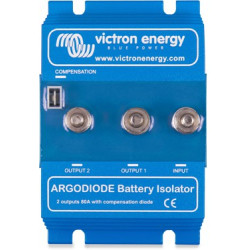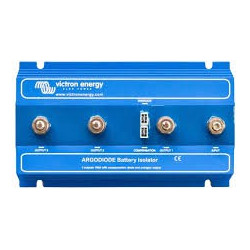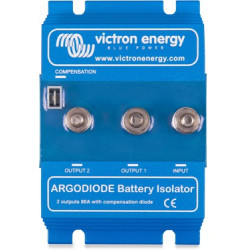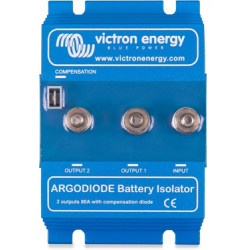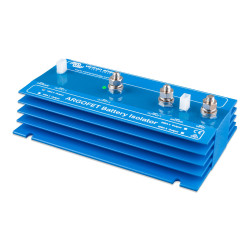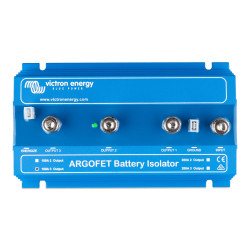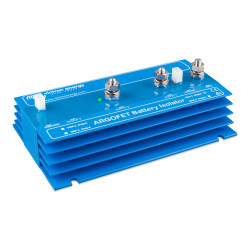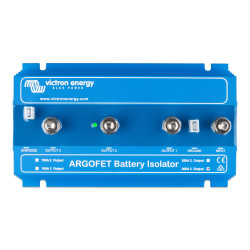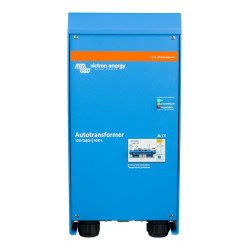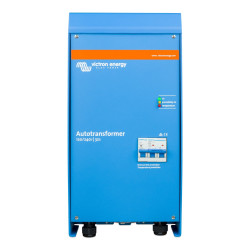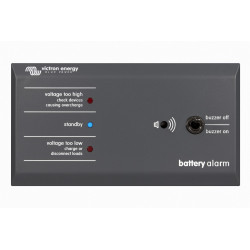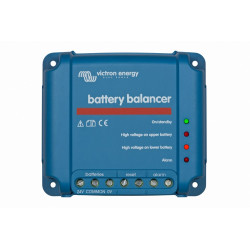Victron Argodiode 160-2AC 2 batteries 160A
Argodiode Battery Isolators allow simultaneous charging of two or more batteries from one alternator, without connecting the batteries together. Discharging the accessory battery for example will not result in also discharging the starter battery. Low voltage drop due to the use of high efficiency Schottky diodes.
Victron Argodiode 180-3AC 3 batteries 180A
Argodiode Battery Isolators allow simultaneous charging of two or more batteries from one alternator, without connecting the batteries together. Discharging the accessory battery for example will not result in also discharging the starter battery. Low voltage drop due to the use of high efficiency Schottky diodes.
Victron Argodiode 80-2AC 2 batteries 80A
Argodiode Battery Isolators allow simultaneous charging of two or more batteries from one alternator, without connecting the batteries together. Discharging the accessory battery for example will not result in also discharging the starter battery. Low voltage drop due to the use of high efficiency Schottky diodes.
Victron Argodiode 80-2SC 2 batteries 80A
Argodiode Battery Isolators allow simultaneous charging of two or more batteries from one alternator, without connecting the batteries together. Discharging the accessory battery for example will not result in also discharging the starter battery. Low voltage drop due to the use of high efficiency Schottky diodes.
Victron Argofet 100-2 Two batteries 100A
Similarly to Argodiode battery isolators, Argofet isolators allow simultaneous charging of two or more batteries from one alternator (or a single output battery charger), without connecting the batteries together. In contrast with Argodiode battery isolators, Argofet isolators have virtually no voltage loss. Voltage drop is less than 0,02 Volt at low current and averages 0,1 Volt at higher currents.
Victron Argofet 100-3 Three batteries 100A
Similarly to Argodiode battery isolators, Argofet isolators allow simultaneous charging of two or more batteries from one alternator (or a single output battery charger), without connecting the batteries together. In contrast with Argodiode battery isolators, Argofet isolators have virtually no voltage loss. Voltage drop is less than 0,02 Volt at low current and averages 0,1 Volt at higher currents.
Victron Argofet 200-2 Two batteries 200A
Similarly to Argodiode battery isolators, Argofet isolators allow simultaneous charging of two or more batteries from one alternator (or a single output battery charger), without connecting the batteries together. In contrast with Argodiode battery isolators, Argofet isolators have virtually no voltage loss. Voltage drop is less than 0,02 Volt at low current and averages 0,1 Volt at higher currents.
Victron Argofet 200-3 Three batteries 200A
Similarly to Argodiode battery isolators, Argofet isolators allow simultaneous charging of two or more batteries from one alternator (or a single output battery charger), without connecting the batteries together. In contrast with Argodiode battery isolators, Argofet isolators have virtually no voltage loss. Voltage drop is less than 0,02 Volt at low current and averages 0,1 Volt at higher currents.
Victron Autotransformer 120/240V-100A
An Autotransformer can be used for step up, step down and split phase output balancing purposes.
While the step up and step-down functions are fairly straightforward, split phase output balancing may require some more attention.
Victron Autotransformer 120/240V-32A
An Autotransformer can be used for step up, step down and split phase output balancing purposes.
While the step up and step-down functions are fairly straightforward, split phase output balancing may require some more attention.


